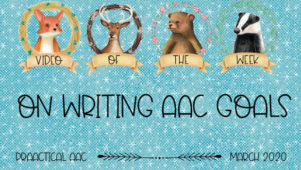PrAACtical AAC Goals

We can not say enough about writing AAC goals that are meaningful to the AAC user, but sometimes this is easier said than done. During discussions in a graduate seminar class, it was apparent that goal writing is not necessarily intuitive or even specifically taught. Goals are also the foundation behind any toy, app, or materials we use to set the stage for meaningful language experiences. Sample goals can serve as inspiration to develop specific, measurable, individualized AAC goals.
For comprehensive information on a range of AAC goals, check out our PrAACtical Goals That Matter or How I Do It- AAC in the IEP by Lauren Enders. But to get started, here are some selected expressive language goals written AAC style.
Expressive Language
Using Prestored Messages (i.e., multiple words/sentences on one cell/button; E.g., a button with “I want music”)
-
Request a turn using prestored messages (e.g., “Hey, don’t forget me! I want a turn.”)
-
Request desired objects/actions using prestored messages (e.g., “Turn the page, please” or “I want more”)
-
Protest (or reject) undesired objects/actions/activities using prestored messages (e.g., “No, thank you. I don’t like that.”)
-
Gain attention using prestored messages (e.g., “Excuse me. I need you for a minute.” “Look at this!”)
-
Express a repeated line in a book, chant, or song (e.g., “All around the town!” “Clean up, clean up, everybody, everywhere”)
-
Use greetings appropriate to the context (e.g., “Hello” “See you later”)
-
Show off (e.g., “Look at me!” “I made it.”)
-
Make a contextually-appropriate comment (e.g., “That’s just crazy!”)
-
Tell about a prior or planned event (e.g., “We played Hungry Hippos in speech today!” “Jenna’s class is having a pizza party on Friday.”)
-
Tell a personal narrative (Note: this can be prestored in one cell/button or distributed across several)
-
Retell a story or event (Note: this can be prestored in one cell/button or distributed across several)
-
Ask a question (e.g., “What’s that?” “What do you think?”)
-
Express agreement or disagreement (e.g., “That’s right.” “I don’t think so.”)
-
Give directions (e.g., “Red Group, line up” “Put it in my backpack, please.”)
-
Use interjections (e.g., “Awesome job!” “No way!” “Wow! That’s crazy!”
-
Use introductory messages (e.g., “Hi. How are you?” “Good to see you”)
-
Use continuers (e.g., “I see.” “Hmm. That’s interesting.” “Okay”)
-
Using termination messages (e.g. “Okay, see you later.” “I gotta run.”)
-
Provide partner instructions (e.g., “It’s going to take me a minute. Please hang with me.” “Say each word as I point to it. If you’re wrong, I’ll shake my head and show you the right one.” “Ask me yes/no questions.”
Using Single Words That Can be Combined into Sentences (i.e., 1 word per cell/button; e.g. I+want+music=”I want music”)
-
Given an array of preferred activities/objects/people, request a desired activity/object
-
Given a field of ___ to ___ options (some preferred, some non-preferred), choose a preferred object/activity/person
-
Request recurrence with single words (e.g., “more,” “again”) or short sentences (e.g., “more tickle,” “Read it again.”)
-
Use short sentences to request preferred objects, actions/activities, or people
-
Use short sentences to request help or attention
-
Use short sentences to protest or reject undesired objects, actions/activities, or people
-
Use contextually-appropriate action + object sentences (or agent + action + object sentences)
-
Use contextually-appropriate agent + action sentences
-
Use contextually-appropriate action + modifier sentences
-
Use contextually-appropriate descriptors/modifiers/attributes in sentences
-
Use contextually-appropriate prepositions and locatives in sentences
-
Use subject pronouns correctly (e.g., (I, you, we, it)
-
Use object pronouns correctly (e.g., me, her, us, them)
-
Use indefinite pronouns correctly (e.g., all, another, someone, anybody)
-
Use time-related words(e.g., ‘yesterday’, ‘now’, ‘soon’, ‘later’)
-
Ask relevant ‘What’ questions or ‘What doing’ questions
-
Ask relevant ‘Where’ questions
-
Ask relevant ‘When’ questions
-
Ask relevant ‘Why’ questions
-
Ask relevant ‘How’ questions
-
Request clarification (e.g., “Can you explain?”“Huh?” “What did you say?”)
-
Ask relevant partner-focused questions (e.g., “What do you think?” “How was your weekend?” “What’s new?”)
-
Use adjectives correctly to modify nouns based on color, size, amount, shape, and temperature (e.g., warm, tiny, bright, round)
-
Use adjectives and adverbs correctly to modify nouns based/verbs on distance and time (e.g., far, sometimes, early, never, short, always, immediately)
-
Respond to ‘What’ and ‘What doing’ questions with appropriate answers
-
Respond to ‘Where’ questions with appropriate answers
-
Respond to ‘When’ questions with appropriate answers
-
Respond to ‘Why’ questions with appropriate answers
-
Respond to ‘How’ questions with appropriate answers
-
Respond to ‘yes/no’ questions to denote choice
-
Respond to ‘yes/no’ questions to provide information
-
Tell or retell a story with ____ number of critical elements
-
Take several turns in a conversation
-
Construct utterances about future events
-
Construct utterances about current events
-
Construct utterances about past events
-
Use non-literal language (idioms, figurative language) appropriately
-
Request an explanation or elaboration
-
Use existing vocabulary to describe new word/concept
-
Use at least __ new words per week
-
Use correct morphological endings for verb conjugations and tenses (e.g., I am, you are; I am, I was)
-
Use modal and auxiliary verbs (e.g., could, would, may, might) correctly
-
Use words to indicate spatial locations (e.g., in, on, over, above) correctly
-
Use words to indicated spatial relationships (e.g., with, next to, between, among ) correctly
-
Use coordinating conjunctions (e.g., and, for, but, or) correctly
-
Use subordinating conjunctions (e.g., because, while, though, since, after, although)correctly
-
Initiate interaction
-
Respond appropriately to partner-initiated communication
-
Maintain conversations with acknowledgements (‘Cool,” “So interesting”)
-
Maintain conversations by providing new information about the topic
-
Re-direct the topic of conversation using cohesive messages (e.g., “That reminds me of…” “I forgot to tell you about…” “I remember…” “Another thing that…”)
-
Use topic setters to alert partner of the topic/subject
-
Terminate conversation using socially-appropriate language
-
Complain or vent about a situation
-
Use polite social forms (i.e, “please”, “thank you”)
-
Compliment others about concrete attributes (e.g., “I like your hair.” “Nice dress”) or abstract characteristics (e.g., “You’re so nice!” “That was a smart thing to ask.”)
-
Respond to requests for clarification by rephrasing misunderstood messages
-
Respond to requests for clarification by repeating misunderstood messages
-
Tell appropriate jokes or humorous anecdotes in social interactions
-
Provide relevant reasons and rationales
-
Convince or persuade with logical reasoning
Filed under: PrAACtical Thinking
Tagged With: AAC goals, goal setting, goals
This post was written by Robin Parker





4 Comments
Hello,
Just wondering how you would make them measurable for the IEP? Specifically the first five.
Thanks!
Awesome Goals, thanks!
These are wonderful! Thank you so much!
Regarding making them measurable, I generally either think in terms of # of times/day or number of times elicited during a session or percentage/accuracy (less relevant with these specific communication tasks).